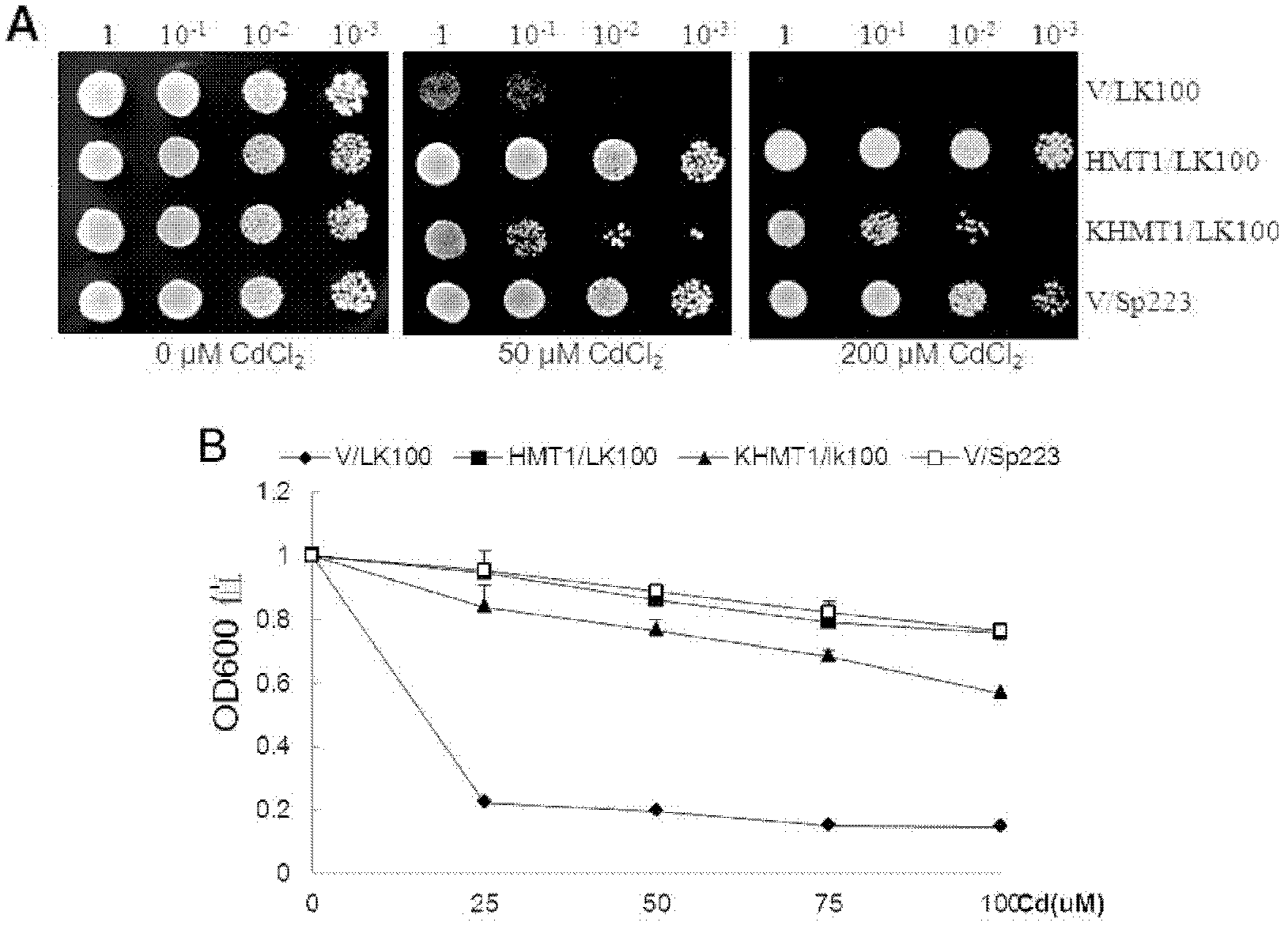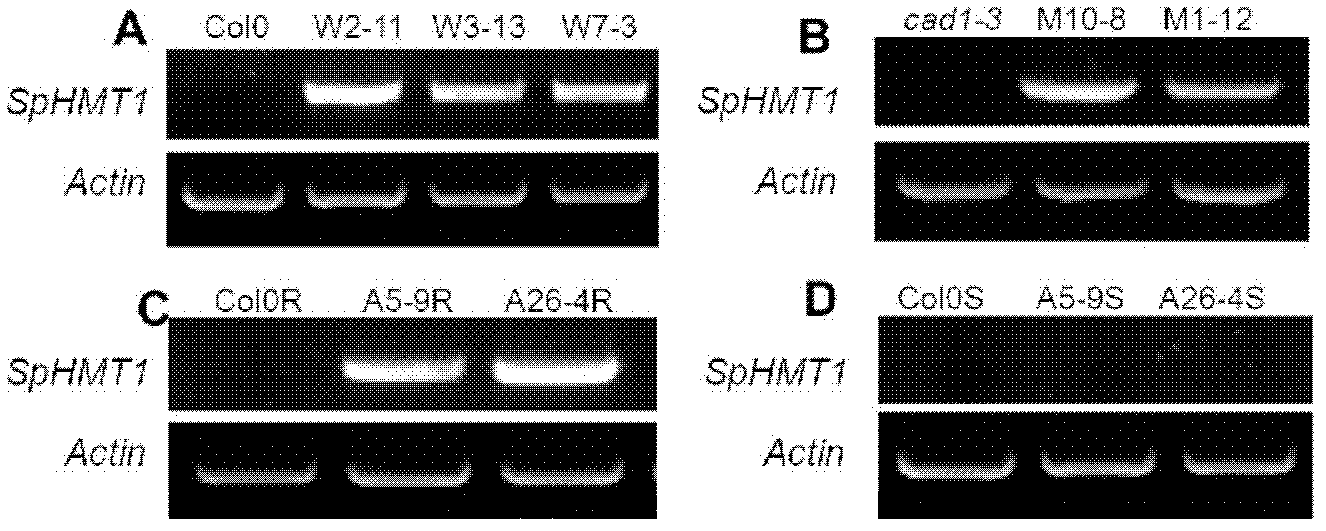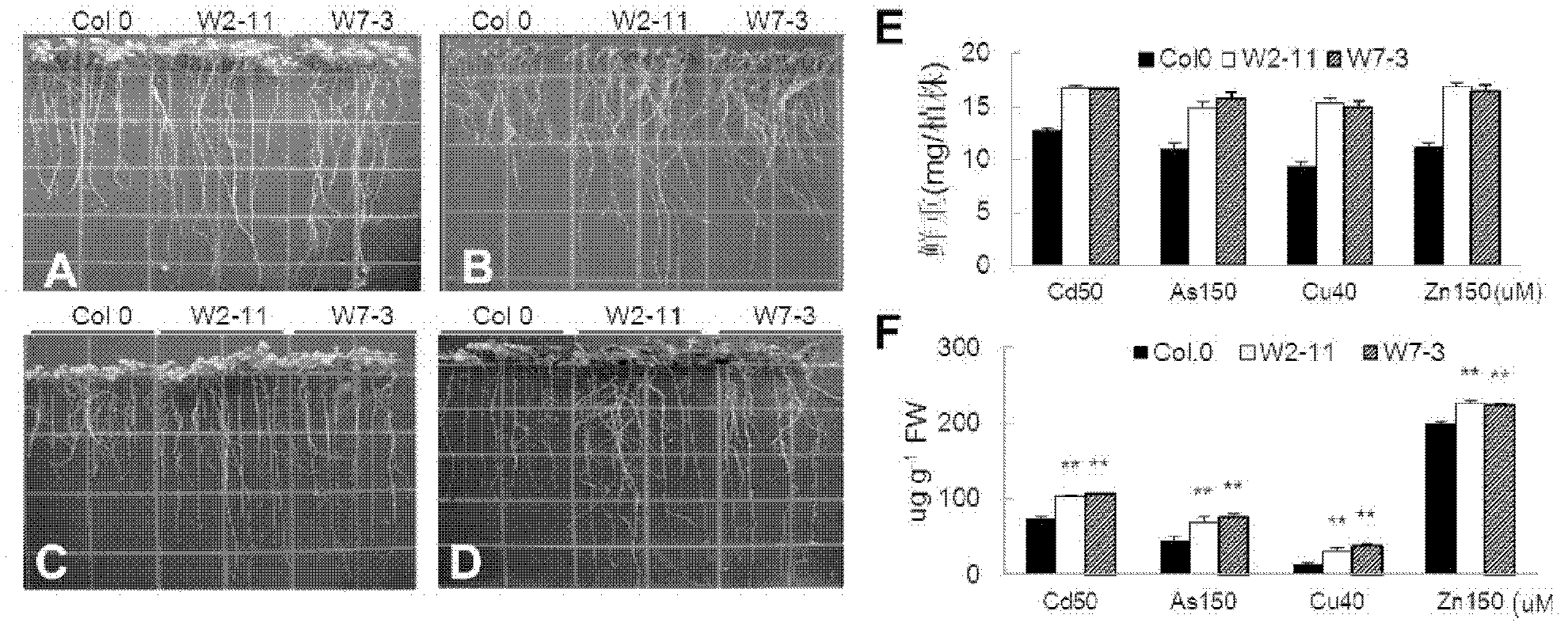Method for improving plant heavy metal tolerance and regulating heavy metal oriented distribution
A heavy metal, tolerance technology, applied in the fields of botanical equipment and methods, biochemical equipment and methods, plant products, etc., can solve the problem of unclear molecular mechanism of reduction and migration, etc.
- Summary
- Abstract
- Description
- Claims
- Application Information
AI Technical Summary
Problems solved by technology
Method used
Image
Examples
Embodiment 1
[0137] Example 1. Cloning and Transformation of Tonoplast Membrane Transporter Gene SpHMT1
[0138] The present inventors used fission yeast (S. pombe) cDNA as a template, through SpHMT1 cloning primers (SpHMT1(+)-PCR and SpHMT1(-)-PCR), and KOD-plus reaction system to amplify the 5'-UTR in SpHMT1 full-length cDNA within. At the same time, primers (K-SpHMT1(+)-PCR and K-SpHMT1(-)-PCR) were designed to clone the cDNA that replaced the 5'-UTR of yeast itself with the Kozak sequence conserved in higher plants. Primers were designed to mutate the stop codon of cDNA (from sequence TAA to TCA) and introduce SpeI restriction site. The cDNA was constructed into the 35S / TaPCS1:cmyc-pBI121 expression vector using the SpeI restriction site (references Jiming GONG et al., Long-distance root-to-shoot transport of phytochelatins and cadmium in Arabidopsis. (2003); PNAS, vol. 100, no.17, 10118-10123; constructed as follows: introduce wheat TaPCS1 containing BamHI / SpeI sites at both ends in...
Embodiment 2
[0165] Example 2, the successful overexpression of yeast gene SpHMT1 in Arabidopsis
[0166] The preparation method of transgenic plants (35S:SpHMT1 / Col-0; 35S:SpHMT1 / cad1-3; Adh:SpHMT1 / Col-0) is as follows:
[0167] The plasmid 35S / SpHMT1:cmyc-pBI121 constructed above was used to transform wild-type C01-0 and AtPCS1 deletion mutant cad1-3, respectively. The previously constructed plasmid Adh / SpHMT1:cmyc-pBI121 was transformed into wild-type Col-0. Arabidopsis transformation method refers to the literature Floral dip: a simplified method for Agrobacterium-mediated transformation of Arabidopsis thaliana. (1998)
[0168] In the shoots, leaves and roots of transgenic Arabidopsis plants 35S:SpHMT1 / Col-0, Adh:SpHMT1 / Col-0 and 35S:SpHMT1 / cad1-3, the expression of SphMT1 was analyzed by RT-PCR.
[0169] RT-PCR primer sequences:
[0170] SpHMT1(+) RT-PCR: TATCTTAAGCAAGAGCGGAAGG (SEQ ID NO: 5);
[0171] SpHMT1(-) RT-PCR: CTTTAAGCCTCTTTCTCCGACA (SEQ ID NO: 6);
[0172] AtACT1 (+) R...
Embodiment 3
[0184] Example 3, SpHMT1 gene can enhance the resistance and accumulation of wild-type Arabidopsis to heavy metals, and its function depends on phytochelatin PCs
[0185] Heavy metal resistance plate test:
[0186] The T3 generation of transgenic plants and the corresponding control were vertically cultured on the 1 / 4×MS plate with different concentrations of heavy metals after the seed surface was sterilized. After about 4 weeks of growth, they were photographed and observed, and the fresh weight was counted.
[0187] Determination of heavy metal content:
[0188] After the heavy metal treatment, the plant material was washed twice with deionized water for 4 min each time, and then washed with 25 mM CaCl 2 (PH4-5) wash twice, 4min each time, and finally rinse in Milli-Q water. 80°C, 48 hours. Weigh the dry weight, add 1 mL of 70% nitric acid (MOS grade), and let stand for 12 hours. Nitrolysis at 99°C for 2 hours, cooled to room temperature, diluted to 14 mL with Milli-Q w...
PUM
 Login to View More
Login to View More Abstract
Description
Claims
Application Information
 Login to View More
Login to View More - R&D
- Intellectual Property
- Life Sciences
- Materials
- Tech Scout
- Unparalleled Data Quality
- Higher Quality Content
- 60% Fewer Hallucinations
Browse by: Latest US Patents, China's latest patents, Technical Efficacy Thesaurus, Application Domain, Technology Topic, Popular Technical Reports.
© 2025 PatSnap. All rights reserved.Legal|Privacy policy|Modern Slavery Act Transparency Statement|Sitemap|About US| Contact US: help@patsnap.com



